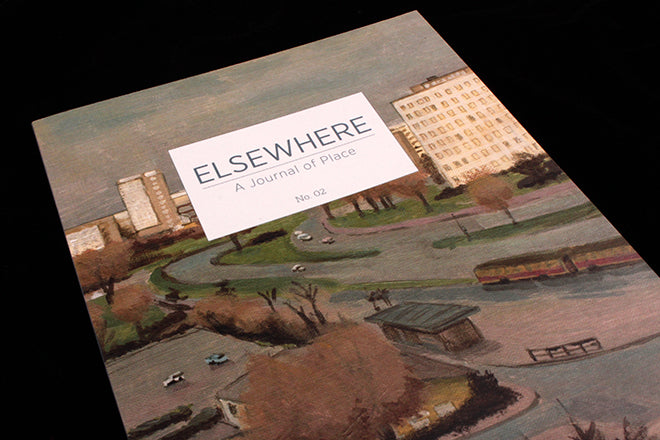
Elsewhere #2
In the tradition of W.G. Sebald and following in the footsteps of Robert MacFarlane and Iain Sinclair, Elsewhere journal sets out to tell stories through place. Yet it is definitely not a “travel” magazine in the traditional sense, although as editor Paul Scraton says, ‘there would of course be an element of that.’ Instead, Elsewhere sets out to traverse the ground where classic travel writing meets ‘reportage, journalism, memoir and short stories.’ They’ve chosen this approach because, as Paul says, ‘there are many ways to explore the essence of place, and we wanted to have space for all of them.’
 The journal is printed in Berlin, yet the places its writing reaches are far and wide – from an eccentric hotel in Kyrgyzstan, to a rocky corner on the coast of Spain, to the suburbs of Mexico. ‘Elsewhere is made in a number of places,’ says Paul from his desk in Berlin-Wedding, which overlooks a classic Berlin courtyard, ‘It’s made in the experiences and imagination of the writers, photographers and illustrators of course. Here, at my desk. At Art Director Julia’s desk, in Berlin-Neukölln, looking out over the street in an ever-changing neighbourhood. And in both of our travels; all our journeys in Berlin and beyond inform our work.’
The journal is printed in Berlin, yet the places its writing reaches are far and wide – from an eccentric hotel in Kyrgyzstan, to a rocky corner on the coast of Spain, to the suburbs of Mexico. ‘Elsewhere is made in a number of places,’ says Paul from his desk in Berlin-Wedding, which overlooks a classic Berlin courtyard, ‘It’s made in the experiences and imagination of the writers, photographers and illustrators of course. Here, at my desk. At Art Director Julia’s desk, in Berlin-Neukölln, looking out over the street in an ever-changing neighbourhood. And in both of our travels; all our journeys in Berlin and beyond inform our work.’

 The choice to illustrate each article harkens back to illustrated literary journals of the past, and the images have an intriguing noir-like atmosphere to them that’s made contemporary by a tinge of grey-blue. Each cover is painted to distinguish from the inside illustrations, but also to stand out from the newsstands, where photography or graphic imagery reign supreme.
The choice to illustrate each article harkens back to illustrated literary journals of the past, and the images have an intriguing noir-like atmosphere to them that’s made contemporary by a tinge of grey-blue. Each cover is painted to distinguish from the inside illustrations, but also to stand out from the newsstands, where photography or graphic imagery reign supreme.
The painted cover of issue two refers to Paula Kirby’s essay on Dresden in the GDR: it’s copied from a photograph taken from Paula’s balcony when she lived there in the 1980s. The article and painting take you to the atmosphere of a place that no longer exists, seeing that Dresden has dramatically changed over the last 25 years since the fall of the Wall. ‘It can be said to be the “lost country” of Paula’s title’, says Paul, intrigued by the kind of time-travel that is possible when words and images come together in the right way.
 The process of writing, reading and editing these essays and articles about place has profoundly contributed to Paul’s desire to produce the magazine: ‘They shape how you think about all the places in your own life, and you realise that there is something interesting in everywhere you have been or might one day go to. I guess that is also a motivation for the journal, to inspire people into thinking a bit deeper about their own understanding or experience of the places around them.’
The process of writing, reading and editing these essays and articles about place has profoundly contributed to Paul’s desire to produce the magazine: ‘They shape how you think about all the places in your own life, and you realise that there is something interesting in everywhere you have been or might one day go to. I guess that is also a motivation for the journal, to inspire people into thinking a bit deeper about their own understanding or experience of the places around them.’
Looking at the places around me, it seems that there’s not just an interest in place in literature at the moment – the topic seems to be pressing on a lot of minds locally in Berlin. There’s of course Flaneur, meticulously uncovering the meaning of place one street at a time, and there’s also website Slow Travel Berlin – an online guide encouraging a closer-look at the stories engrained in a neighbourhood. I myself first heard about Elsewhere when I moved to Wedding and heard Paul reading at an event about the history of the local community, a neighbourhood that even boasts its own magazine, Der Wedding. Looking closely at a place, you can find a lot of stories there, but increasingly you can find a lot of people documenting and uncovering those stories too.
Creative director: Julia Stone


